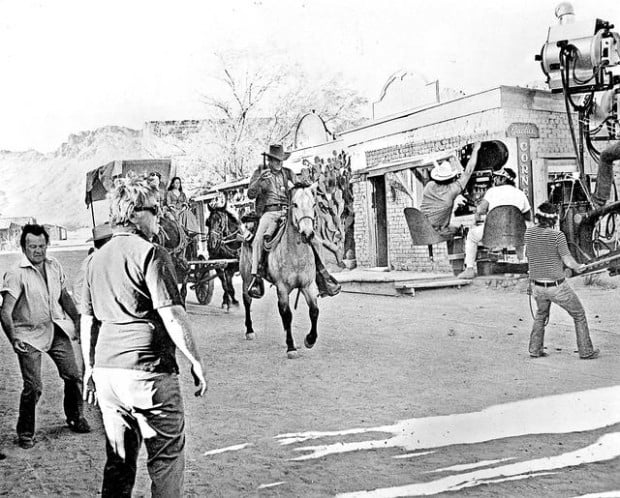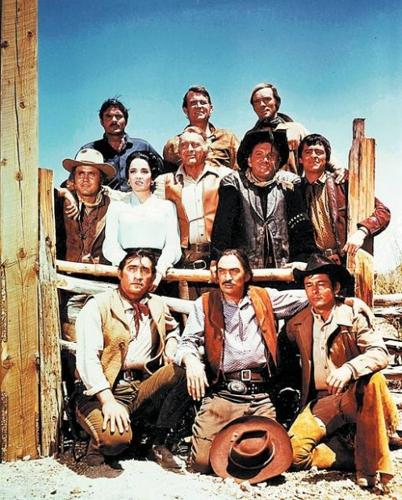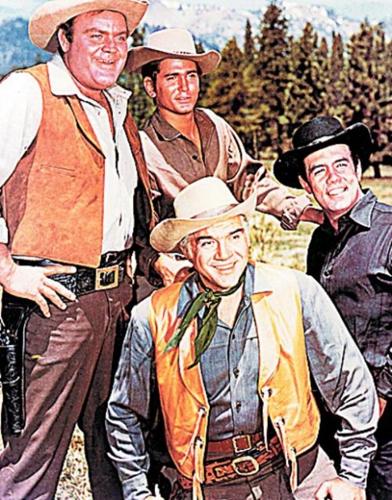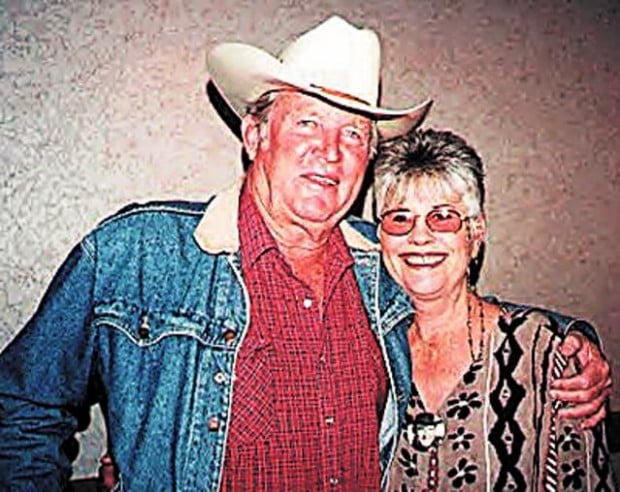In the near future, the Tucson background, which has been used to good advantage in motion pictures, probably will be flashing on television screens in homes throughout the country.
— Arizona Daily Star, June 5, 1949
Tucson was born to be a TV star. In fact, the Old Pueblo starred on TV before television signals reached Tucson living rooms.
In spring 1949, the magnificent technological marvel had yet to appear in our dusty neck of the desert. Already, though, New York's WCBS had aired a half-hour special on the Fiesta de los Vaqueros festivities.
"CBS officials told radio station KTUC here that the film was very well done and very clear," the Star reported on May 1, 1949, "and that they had been greatly impressed by the films of the opening day's festivities of the rodeo including the parade shots."
And so Tucson's fascinating TV history began. In June 1949, the Star reported that standing-room crowds would gather at Tucson radio stores to catch the first TV broadcast waves. The signals were aided by the stores' powerful antennae.
Not everyone was impressed.
"If all TV dramas are as simple as the Charlie Ruggles show televised from 8 until 8:30 p.m., radio has nothing to fear after the video novelty wears off," snipped an anonymous writer in the Dec. 5, 1949, Star.
The taste of the future touched off a clamor for the magic box, and in 1952 the government authorized two local stations, KVOA (Channel 4) and Old Pueblo Broadcasting Company (Channel 13). Tucson was one of the smallest population centers in the country to be allowed two stations, the article said. Sundry delays pushed the debut of local TV to the next year.
"Like a wide-eyed child with a new toy, Tucson will welcome television to its homes in 1953," an unnamed Star reporter wrote breathlessly on Jan. 11, 1953. By the end of the year, half of Tucson homes would own a TV, predicted KVOA public relations director E.P.H. James.
It didn't take long for Hollywood to bust open the barn doors. In the golden age for Westerns, giants including "Gunsmoke" and "Bonanza" trotted in for on-location episodes, and productions took advantage of Old Tucson — built for the film "Arizona" in 1939 and used by movie studios since 1940.
Many more followed, and Tucson was enriched with the flow of money and celebrity attention for decades. Bob Shelton, who owned Old Tucson from 1959 to 1985, recalled as many as four shows shooting simultaneously at times in the 1960s and '70s.
Then the well dried up in the early 1990s, due to Canadian and New Mexican tax incentives to movie makers as well as the fire at Old Tucson in 1995.
"Without a doubt, New Mexico is our biggest competitor principally because their film incentive program is more lucrative than ours right now," said Frances Causey, Old Tucson film manager. "Hopefully, that is changing. It is hard for producers to justify shooting in Arizona when the savings are so much greater next door."
Shelli Hall, Tucson Film Office director, who is working to draft new legislation that would beef up Arizona's tax incentives, agreed that New Mexico is the state's chief rival, and added that Marfa, Texas, where recent Westerns "No Country for Old Men" and "There Will Be Blood" were shot, is also an emerging juggernaut. Canada, however, is the new Hollywood, but the country is suffering just like Arizona because of aggressive tax incentives in some American states.
"When I started in this job 10 years ago, the Directors Guild of America did a 'runaway production' study, and they found that 98 percent of TV movies of the week were being filmed in Canada. In the 1980s, movies of the week were big business for Tucson," Hall said.
"But due to Canada's exchange rate, less union restrictions, tax credits and loan programs, it became more cost effective to shoot there. Canada has a huge infrastructure and workforce to support film production, and right now they are really hurting because of New Mexico, Louisiana, Connecticut — states with great incentive programs."
Tucson's history with film and TV, as well as its proximity to Los Angeles, could give it a boost if it can generate tax incentives and infrastructure to match its rivals.
With their bigger budgets and ambitions, movies make up the lion's share of Tucson's "screen" history. Still, some of TV's most memorable early shows join lesser or never knowns to make up our legacy on the small screen.
Today we reminisce about the programs I've chosen, with input from Bob Shelton, as the 10 most significant shows in Tucson TV history.
Top 10 television shows
1 The High Chaparral (1967-71)
Network: NBC.
Stars: Leif Erickson, Cameron Mitchell, Henry Darrow, Don Collier, Linda Cristal.
Local locations: Old Tucson, San Pedro Valley, Aravaipa Creek.
Just as the filming of "Arizona" will forever define Southern Arizona's movie scene, "The High Chaparral" stands as the most important Tucson-made TV show. The production proved that a series filmed largely in Tucson could be successful, and it was a financial boon to the area because NBC spent as much as $300,000 filming each episode, the Star reported in 1967.
And the gift would keep on giving. "The High Chaparral" production manager, Kent McCray, persuaded his close associate Michael Landon to shoot episodes of "Little House on the Prairie," "Father Murphy" and "Highway to Heaven" in Tucson.
"I think 'The High Chaparral' did more for the motion picture business and prosperity here than any one thing ever did," said Bob Shelton, who ran Old Tucson from 1959 to 1985.
The series followed the adventures of Leif Erickson's character, Arizona Territory rancher Big John Cannon, as he built his cattle business and fended off attacks from Indians.
"It was a fantastic series we were blessed with that was really kind of our afterburner kick," Shelton said. "When they came here, they were great to work with. I had known some of the guys from NBC. The producer was the one who did 'Bonanza' — David Dortort. They came here and built a ranch house on the east side of Old Tucson."
Don Collier, an actor who played ranch foreman Sam Butler, would later transplant to Tucson and recalled his enjoyable days shooting the series.
"It was 12- or 13-hour days, but they were fun days," said Collier, who is recognizable more recently for work on the local show "The Desert Speaks." "I had a lot of fun with it. We tried to film it like a real working cattle ranch and did roundups, branding and everything you do on a ranch."
Collier said he and the rest of the cast were tight and "did our share of drinking." They passed the off hours playing cards and dominoes and would visit Nogales. The cast and crew stayed at local hotels including the Ramada Inn and Desert Inn.
2 Bonanza (1959-73)
Network: NBC.
Stars: Lorne Greene, Michael Landon, Dan Blocker, Pernell Roberts.
Local locations: Old Tucson, Empire Ranch.
One of the first TV series to be broadcast in color, "Bonanza," the top-rated show from 1965 to 1968, is a giant. Shooting in one of the great cities of the Old West was a natural.
The Civil War-era saga featured Ben Cartwright (Lorne Greene), a Nevada rancher with three sons by different wives, all of whom had died. The Cartwrights run their ranch, help others and fend off attacks. Shelton said the series filmed episodes here in 1966, 1971 and 1972.
"There was always a big crowd when 'Bonanza' shot here," Shelton said. "It was a great occasion."
3 Gunsmoke (1955-75)
Network: CBS.
Stars: James Arness, Milburn Stone, Amanda Blake.
Local location: Old Tucson.
The second-longest-running fictional prime-time TV series (Disney's anthology program known under various names, including "The Wonderful World of Disney," is the longest-running series), "Gunsmoke" shot in more than a dozen locations throughout California, Utah, South Dakota and Arizona.
The series started off as a radio drama before moving to TV. Then the radio and TV versions ran concurrently until 1961, when "Gunsmoke" shifted solely to TV.
Set in Dodge City, Kan., the show follows gruff Marshal Matt Dillon (James Arness) as he deals with problems such as gunfights, cattle rustling and land fraud.
Shelton said one episode and parts of two others were shot in Tucson.
"They were all business," Shelton said of the "Gunsmoke" crew, noting that its presence led to more productions coming to Tucson.
"Gunsmoke" executive producer John Mantley returned to Tucson with the series "How the West Was Won," and producer Leonard Katzman followed with "Petrocelli."
4 The Young Riders (1989-92)
Network: ABC.
Stars: Stephen Baldwin, Josh Brolin, Ty Miller.
Local locations: Old Tucson, Gates Pass, Mescal (Old Tucson's alternate location, east of Tucson).
Another show Tucson had all to its own was "The Young Riders." The plucky drama about the exploits of Pony Express riders never quite caught fire nationally because it was pitted against "Cheers." Still, it stampeded through three seasons and was beloved in Tucson.
Sadly, once "The Young Riders" was canceled, so was Tucson's relevance as a TV town.
Barbara Glover, a local actress, appeared in the show as various characters.
"All of my male actor friends worked a lot on that show. There was always bad guys/the gang, etc. As in most Westerns, very few parts for women," Glover said.
"One of the parts I was cast in was a 'townsfolk.' It was really written for a man; some of my dialogue was 'There's going to be hell to pay now,' something most women would not have said in those times."
The production would shoot between July and February and once stopped traffic for hours for a scene at Gates Pass.
5 Father Murphy (1981-83)
Network: NBC.
Stars: Merlin Olsen, Katherine Cannon, Timothy Gibbs.
Local locations: Old Tucson, Rio Rico.
Series creator Michael Landon adopted Tucson as his honorary home for much of the 1980s. His experience shooting an episode of "Little House on the Prairie" at the University of Arizona campus in September 1981 may have been the reason. Eighty students were cast as extras, and Landon was mobbed by autograph seekers.
"They've got great streets there, and the extras we can hire are just fantastic," said Landon, who bought land in Southern Arizona and later returned to shoot part of an episode of "Highway to Heaven" at Hi Corbett Field in 1985. He took part in Tucson's Michael Landon Celebrity Tennis Classic, which ran from 1983 to 1991, the year he died of pancreatic cancer. The tournament was renamed the Beau Bridges Celebrity Tennis Classic.
Landon returned with "Father Murphy," which was set in the 1870s and starred Merlin Olsen as a frontiersmen who masqueraded as a priest to help orphans find homes. Later he winds up adopting the kids. To shoot "Father Murphy," people with the show had to cover saguaros to disguise the backdrop as Dakota Territory.
When the series was canceled after two seasons, it was replaced by "The A-Team."
"I knew (Landon) really well. I played tennis with him," Shelton said. "He loved it. He bought a lot of real estate here. . . . He had a lot of money and made a lot of money. Every year he'd buy a lot of real estate and sell it at a profit. He was big time."
6 Hey Dude (1989-91)
Network: Nickelodeon.
Stars: Christine Taylor, Joe Torres, Josh Tygiel.
Local location: Tanque Verde Guest Ranch.
Two Tucson schoolboys found sudden stardom when they were cast in Nickelodeon's comedy about teens dealing with life while working at a dude ranch.
Joe Torres, a 17-year-old Tucson High School senior, and Josh Tygiel, a 13-year-old attending the school now known as Utterback Middle Magnet School, landed starring roles that disappointingly didn't lead to bigger things after the show ended. The show lasted 65 episodes and ran in syndication until 1999.
7 Bearcats! (1971)
Network: CBS.
Stars: Rod Taylor, Dennis Cole.
Local location: Old Tucson.
Filmed at Old Tucson and in New Mexico, the action drama was set in the early 20th century and tracked the adventures of two mercenaries, played by Taylor and Cole. The duo cruised around in a 1914 Stutz Bearcat automobile and took on assignments for pay in blank checks.
"It was a modern version of a Western, and they had that car," Shelton said. "It was a good show, very interesting."
The show lasted half a season before it was canceled.
8 Ballad of the Old West (1971)
Network: Unknown.
Stars: Johnny Cash, Kirk Douglas, Roy Rogers, Walter Brennan.
Local locations: Old Tucson.
Although there doesn't seem to be a record of the series airing, filming the variety-style show here was a coup because of the star power it brought to town.
"It was a fun show. They filmed it on the soundstage here," Shelton said. "Part of the show they recorded in the studio, and Roy and Johnny Cash worked on a street gunfight with Kirk Douglas. At night, they'd get to the hotel (the old Hilton on North Oracle Road), and Johnny Cash and Willie (Nelson) and all those guys would jump into somebody's room, start picking on guitars."
9 Have Gun — Will Travel (1957-63)
Network: CBS.
Stars: Richard Boone, Kam Tong.
Local location: Old Tucson.
The sprawling series about a traveling professional gunfighter played by Richard Boone touched Old Tucson for some episodes.
The TV series is set to be remade as a movie starring Eminem, projected to be released this year.
"We became pretty well known in the early '60s. I had restored the street and was making it ready for film use back in those days," Shelton said, recalling the series shooting at Old Tucson in 1962. "There were so damn many Western TV series going on, they began to look at other places other than the backlots of Hollywood. I think that was just the spillover. I began to make my trips out there back then, knocking on doors, telling them we were over here."
Shelton said Boone insisted on playing golf before shooting started and ignored warnings of the blazing sun.
"He was a baked cookie," Shelton said. "We put him to bed, and actually he was knocked out. They were gonna start shooting on Monday morning, but by Sunday he was really a basket case. He was in the Sands Hotel. They kept him company in a room and put an attendant in there to watch him so if he needed anything he could help him out. The attendant decided he wanted to get out to take a smoke, and in the meantime Boone wakes up just burning up. His throat is raw and tongue is swollen. He opens the refrigerator, grabs a pitcher of liquid and gulps it down. He forgot he had made a batch of martinis and set them in there. Two or three gulps of martinis got him so damn sick, he couldn't shoot here."
Shelton said they shot scenes at Old Tucson without Boone and sent him back to Hollywood to visit his doctor.
10 Petrocelli (1974-76)
Network: NBC.
Stars: Barry Newman, Susan Howard.
Local locations: Old Tucson and Downtown.
Newman starred as an Italian-American defense attorney who moved to a small Western town to get away from the bustle of the East. He lives in a trailer while his house is being built and defends clients accused of murder.
"Barry was a heck of a guy, a lot of fun. He loved chasing around all our local chicks," Shelton said. "That was the sport of the day whenever they were around."
Meet the Colliers, the first couple of Tucson TV history.
Don Collier, 79, worked with such legends as John Wayne and Elvis Presley in half a century of movies and television, starring in the Tucson-based TV series "The High Chaparral" and "The Young Riders." He lives with his wife, former casting agent Holly Collier, 64, on the East Side and hosted 12 seasons of "The Desert Speaks," a KUAT nature and science show.
Collier and his wife stand as legacies of Tucson's yesteryear glory.
"The desert climate down here is ideal for shooting movies," Collier said. "There's so much sunlight that even rain in the summertime didn't bother us."
After working as an extra in a couple of movies, Collier plunged into acting full time in 1956. His break was a role in the NBC series "Outlaws" in 1960. He later joined the cast of "Bonanza," then landed his defining role as ranch foreman Sam Butler in "The High Chaparral" (1967-71). Collier also appeared on "Little House on the Prairie" and "Highway to Heaven."
Holly started out as a casting agent in Los Angeles. She was responsible for filling roles in several films and TV shows in Tucson, including "The Young Riders," the 1993 film "Tombstone" and the 1994 TV movie "Gunsmoke: One Man's Justice."
"Holly was doing so many films here. She was the leading casting personality," said Bob Shelton, former owner of Old Tucson. "She had a background in Hollywood and had lived there for years (Holly began working in casting in 1968) before she married Don Collier. When Don decided he wanted to move over here and sort of work out of here, she sort of gave up the business. She was still a fairly prominent casting director."
Collier jokes he married Holly to advance his career.
"We met in L.A.," Collier said, noting he was auditioning for a chili commercial. "She had a casting office there. I went in for an audition and got the job. I got a couple of more jobs and figured the best way to get more work was to marry her."
They moved to Tucson together and married here in 1983. Transplanting to Tucson was a no-brainer for the Colliers.
"I just liked it down here," Don Collier said. "I worked down here, and L.A. got so crowded and awful that I decided to move out here. Holly continued working in casting until retiring in 2001 because she suffers from angina."
Holly misses her work and entertains the possibility of returning to casting if her health improves. She says she feels better now than she has in years.
"You bet (I miss it)," she said. "The interaction and activity of it, the excitement of it. I'm enjoying my semi-retirement but I don't know."
Don's workload has slowed, consisting mostly of voice work and the occasional commercial. He laments the decline of Tucson's film industry.
"It's very sad," he said. "Well, there's no town anymore. When Old Tucson burned . . . they didn't build it back like a Western town, but a Western theme park. It's run down and would take a couple million bucks to get it back where it should be. In New Mexico, there are three or four decent Western towns over there."
He has little hope for an industry resurrection here.
"I think we're done," Don said. "Stick a fork in us. . . . As far as production down here, once Old Tucson burned down, that kind of put a dent in the whole thing."
Holly is more optimistic.
"I think there's a good chance it could happen again," she said. "When we were coming in, production was going and everybody was prospering from it, and now it's at a crawl. The city needs to look at that and say, 'Wow, what happened?' and do something about it."
ODDS AND ENDS
Some other notable shows shot at least partly in Tucson:
"Wagon Train" (1957-65)
"Webster" (1983-89)
"Death Valley Days" (1952-75)
"Yuma" (1971)
"The Mark of Zorro" (1974)
"The Fugitive" (1963-67)
"The Hanged Man" (1974)
"Desperation" (2006)
"Young Pioneers" (1976)
"How the West Was Won" (1979)
"Dundee and the Culhane" (1967)
Tax incentives in Arizona, N.M.
The disparity in tax-incentive programs is one reason New Mexico pulled in $452 million in economic impact in the fiscal year 2006-07 thanks to film and television production, while Arizona garnered only $77 million in the same span.
Differences between Arizona and New Mexico's incentive packages:
Tax credits:
• Arizona: offers 20 perdent and 30 percent tax credits on expenditures made in-state.
• New Mexico: offers a 25 percent cash rebate.
Loan program:
• Arizona: has no production loan program.
• New Mexico: offers $15 million in interest-free loans from a $280 million fund.
Production cap:
• Arizona: caps its incentives per production at $7 million and caps its total tax credits at $50 million.
• New Mexico: has no caps.
Annual cap:
• Arizona: distributes its incentives on a first-come, first-served basis, and the cap for 2007 was allocated in January.
• New Mexico: never allocates its total budget because it has no cap.
Source: Tucson Film Office
DID YOU KNOW . . .
The WB sitcom "Greetings From Tucson" (2002-03) was filmed in Hollywood, although it did have many connections to town. The show was set in Tucson and involved the exploits of a Irish/Hispanic family. The short-lived program was executive produced by former Tucsonan Peter Murrieta and included stock shots of local scenery in between scenes. It referenced the local eatery Eegee's in the title of one of its episodes.











